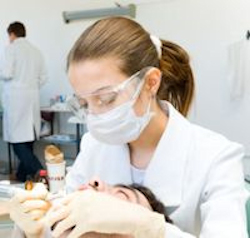Understanding Dental Office Health Risks
Potential Health Hazards
Many dental care professionals are at risk for occupational exposure to a variety of hazardous chemicals and situations. Being unaware of the potential hazards in the work environment makes them more vulnerable to injury.

Let's take a closer look at some of the potential health hazards associated with working in a dental lab.
Methyl methacrylate- This is used in making dentures and plates. It can be absorbed into the body by inhalation, through the skin, and by ingestion. It is irritating to the eyes, skin, and respiratory tract. Repeated and prolonged exposure can cause skin sensitization and asthma, as well as adverse effects on the nervous system.
Electroplating chemicals- The process of electroplating can release hazardous contaminants into the air that pose a variety of risks to the dental lab worker. The contaminants include various acid and alkaline mists that can cause respiratory and skin problems.
Metals- such as beryllium, chromium, cobalt, and nickel can cause lung problems. These metals in alloys are used for castings of bridge framework and other dental prosthesis components.
Repetitive motion disorders- A range of injuries to the muscles, tendons, nerves, ligaments and joints of arms, hands wrists, shoulders, neck and upper back are common in the dental office setting. These injuries result from damage to the body over a period of time. If not treated, they can result in chronic pain and permanent disability.
Noise- grinding, sandblasting, and other dental lab machinery can make noise that can cause hearing loss.
Chemical sterilants- These are used to sterilize impressions and prosthetic devices, received from dental offices, contaminated with blood and saliva. Sterilant chemicals include aldehydes, phenols, and quaternary ammonium compounds. These chemicals may cause lung problems and dermatitis.
Knowledge Check Choose the best answer for the question.
1-1. Which of the following metals can cause lung problems due to overexposure during bridge framework?
You forgot to answer the question!
